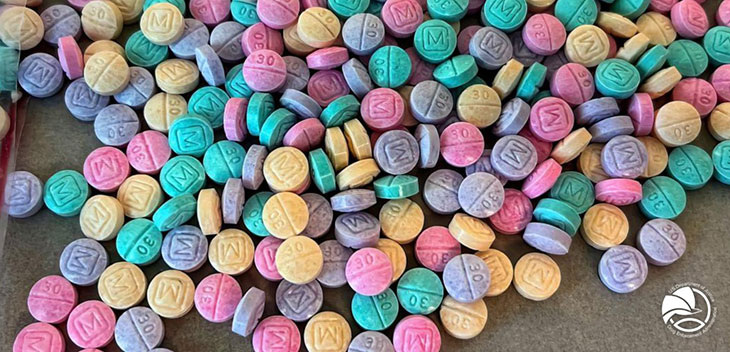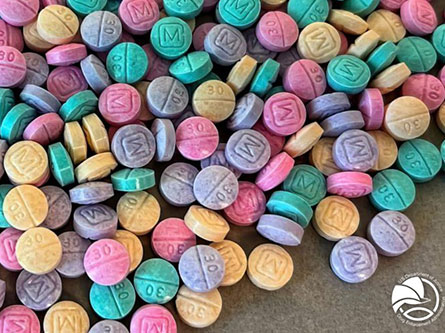
Stories of fentanyl overdoses continue to show up in the national and local news almost daily. In 2020, nearly 4,000 people died due to fentanyl overdoses in California, according to the California Department of Justice.
Many of these fentanyl deaths are young people. Emergency department visits for non-fatal opioid overdoses in Californians ages 10-19 more than tripled from 2018 (379) to 2020 (1,222). This is according to the California Department of Public Health. Fentanyl-related deaths for people ages 10-19 in California surged from 36 in 2018 to 261 in 2020.
How can you protect your family and friends? We have some facts from our substance abuse experts to help you learn more about fentanyl.
What is fentanyl?
Fentanyl is a synthetic opioid made in a lab that is 50 to 100 times more powerful than morphine. It's approved to treat severe pain, typically acute traumatic pain and advanced cancer pain. Fentanyl is widely used in emergency departments and hospitals. It can also be prescribed. However, the recent fentanyl-related deaths are linked to illegally made drugs.
Fentanyl can come in different forms, such as pills, powder, and liquid. It's also been found mixed with other drugs. This includes heroin, counterfeit pills, methamphetamine (meth) and cocaine. Sometimes, fentanyl is used to replace other drugs entirely, according to the California Department of Justice.
Learn more about fentanyl with this fact sheet
What makes fentanyl so dangerous?
Fentanyl is so powerful that a small amount can be deadly. Just two milligrams can cause overdose or death. It can also be very addictive.
You cannot smell or taste fentanyl. This makes it nearly impossible to tell if drugs are laced with the opioid without fentanyl test strips.
Can fentanyl be absorbed through the skin or by touching an item that has fentanyl on it?
No, that is a common myth. Fentanyl cannot be readily absorbed through the skin. You also can't overdose on fentanyl by touching a doorknob or dollar bill. As a result, it is safe to help people who have overdosed on fentanyl.
Fentanyl skin patches can be prescribed by a health care provider. These have a special formulation of the opioid that can be slowly absorbed through the skin. Even then, it takes hours of exposure.
What does fentanyl look like?
Fentanyl is usually available in two main types: powder and liquid.
Powdered fentanyl can be made to look like other drugs. It is often pressed into pills that look exactly like prescription pills, such as Percocet or Xanax.
In the liquid form, illegally made fentanyl can be found as a replacement for heroin. There are also reports of fentanyl being packaged as nasal sprays and eye drops. Additionally, liquid fentanyl can be dropped onto paper or small candies.
What is "rainbow fentanyl"?
"Rainbow fentanyl" is a newer phenomenon. This type of fentanyl is mixed with dyes and either pressed into brightly colored pills or sold as powder in various colors. Drug traffickers are likely using these dyes to avoid detection and appeal to teens and young adults.
There is no indication that certain colors may be more potent than others, as indicated through laboratory testing.
Check out the DEA's fentanyl awareness campaign
Is there anything that can reverse the effects of fentanyl?
Naloxone (also known as Narcan) is a life-saving medication. It can rapidly reverse the effects of opioid overdose if given in time. It's available in all 50 states and can be bought without a prescription in most states.
Naloxone comes in an injectable form or a nasal spray. It works by blocking the effects of opioids and can restore normal breathing within 2-3 minutes. Naloxone can also be used to help people overdosing on drugs other than opioids. It's safe to use if you suspect any type of overdose, not just fentanyl.
Our experts recommend naloxone be available in all public venues. This could be similar to the availability of automated external defibrillators (AEDs). The California Department of Health Care Services offers free naloxone to qualified organizations, including schools and universities.
Learn about naloxone (Narcan) and why you should carry it to combat opioid overdoses
What are signs that someone might be experiencing a fentanyl overdose?
Recognizing a fentanyl overdose can save someone's life. Here are the signs you should look for, according to the CDC:
- Small, constricted "pinpoint" pupils
- Falling asleep or losing consciousness
- Slow, weak, or not breathing
- Choking or gurgling sounds
- Limp body
- Cold and/or clammy skin
- Discolored skin (especially in lips and nails)
What should you do if you suspect a fentanyl overdose?
If you think someone has overdosed on fentanyl, you should:
- Call 911 immediately. (Most states have laws that may protect a person who is overdosing or the person who called for help from legal trouble.)
- Administer the life-saving medication naloxone if you have some.
- Try to keep the person awake and breathing.
- Turn the person on their side to prevent choking.
- Stay with the person until paramedics arrive.
Opioid and substance use disorder resources
If you or someone you know wants help to stop using opioids or other substances, here are some resources to help:
- Substance Use Disorder Treatment (UC Davis Health)
- Substance Abuse and Mental Health Services Administration (U.S. Department of Health and Human Services)
- Substance Abuse and Treatment Resources (CDC)
- Choose Change California (State of California)
- How to find opioid treatment programs (U.S. Department of Health and Human Services)




